From 0 to 70% Market Share: How Google Chrome Ate the Internet
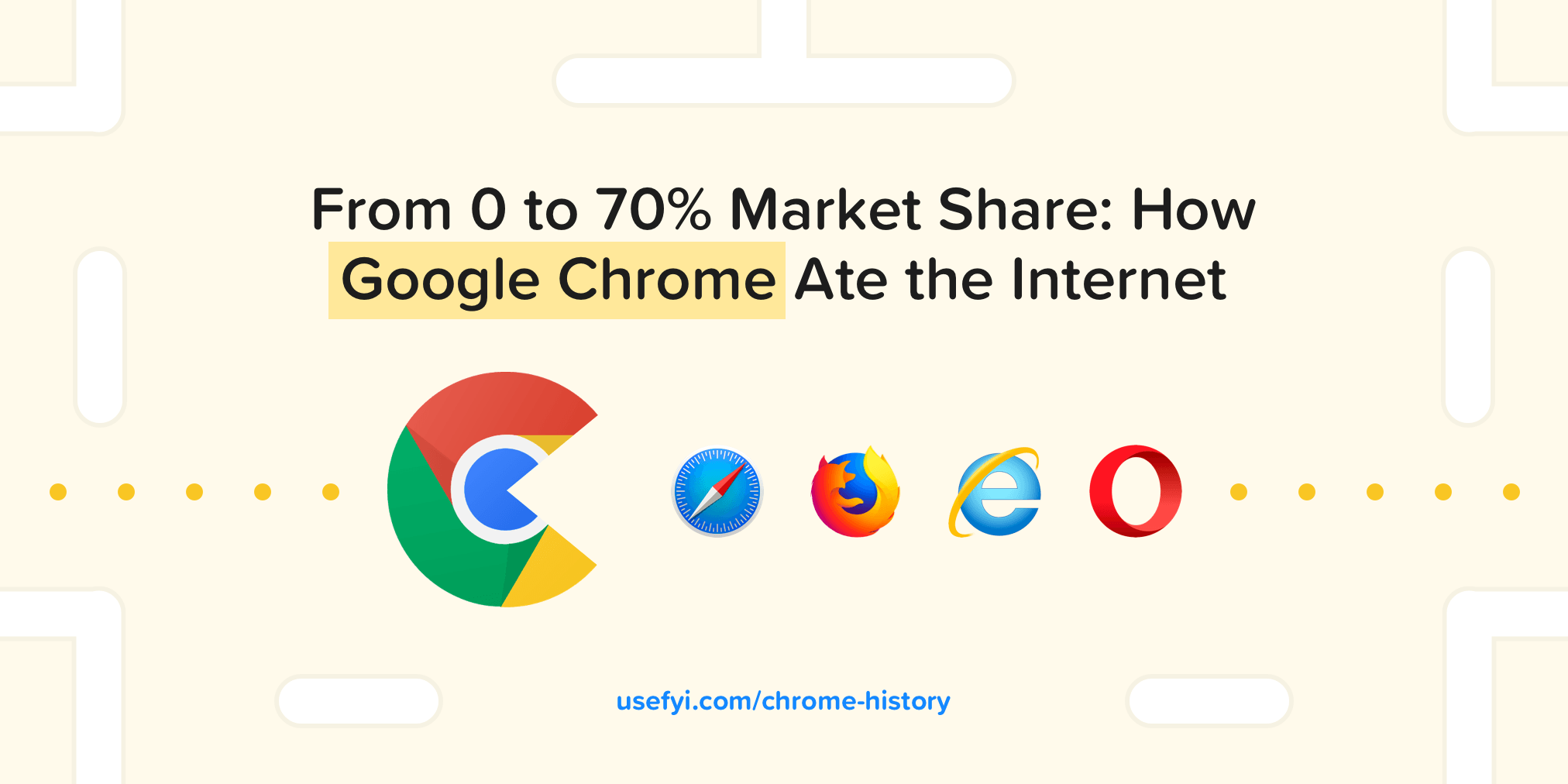
In 2008, Microsoft’s Internet Explorer (IE) web browser had almost 60% of the world’s browser market share. Mozilla’s Firefox was trailing in distant second place with roughly one-third of the market. Google’s brand new Chrome browser, which the search giant debuted on September 2, 2008, had just 0.3% market share.
A decade later, Chrome effectively owned the browser space with market share of almost 70%. How did Google enter and dominate an entirely new sector in just ten years?
By fundamentally reinventing the browser.
Google saw Chrome as a platform from the very beginning. To Google, the browser wasn’t just a means of viewing webpages. It was the nexus of an increasingly diverse range of tools and applications that were changing how we did virtually everything online.
Here’s what will be explored in this article:
- Why developers, not casual Internet users, were Google’s primary target for Chrome
- How Google was able to grow Chrome’s userbase immensely in a short period of time in a crowded market
- How Chrome empowered Google to exert greater influence over broader internet trends
Chrome isn’t just a great browser. It’s also a great example of how a single product can challenge conventional wisdom and reshape how we think about the tools we use every day.
The landscape of the Internet was very different in 2008. The ways in which we used the Internet began to change, Google spied an opportunity to create an entirely new Operating System (OS) for the open web and capitalize on Microsoft’s complacency and the limitations of Internet Explorer.
Vulnerabilities that Google wasted no time in exploiting.
2008-2013: Rethinking the Browser
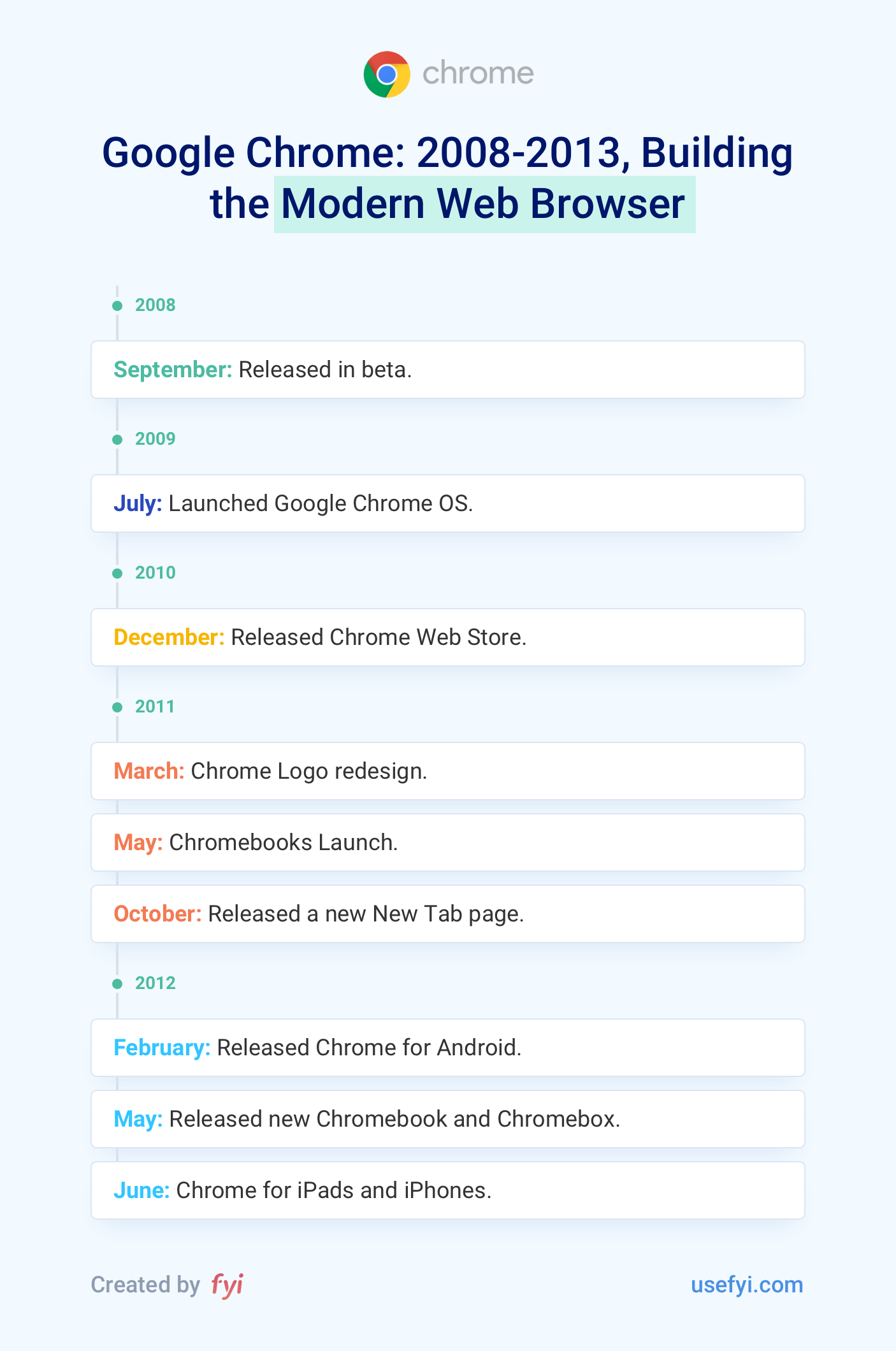
The year is 2008. Apple’s iPhone has been on the market for less than a year. Windows 7 has been available for a few months, and people are still upset about the fate of Windows XP. Yahoo! just rejected Microsoft’s proposed acquisition of the company at $31 per share. And Microsoft’s Internet Explorer is the most popular web browser in the world.
The ecosystem around consumer technology was vastly different in 2008, not just from a hardware perspective. The launch of the iPhone was the catalyst that pushed apps into the mainstream. The problem was that apps weren’t mainstream yet. They were popular, sure, but far from ubiquitous the way they are today.
Apps were available in 2008, but webpages were still how most people interacted with online services.
Online banking was hardly new at that time, but you still had to log into a password-protected webpage to access your account information. You could order goods online, but the chances were pretty good that you did so from a desktop or laptop rather than a mobile device.
The web was changing rapidly. Browsers, on the other hand, were not. Microsoft had made some improvements to Internet Explorer since its debut in 1995, but for the most part, the experience of navigating the web using IE was largely the same in 2008 as it was in 1998.
Google understood that the world needed something new if the promises of Web 2.0 were to be realized. Google also understood it was facing an enormous potential opportunity to beat Microsoft at its own game if it moved fast enough and played its cards right.
Google Chrome officially launched in beta on September 2, 2008. To spread the word about Chrome, Google produced a short comic that explained why Google had created its own browser.
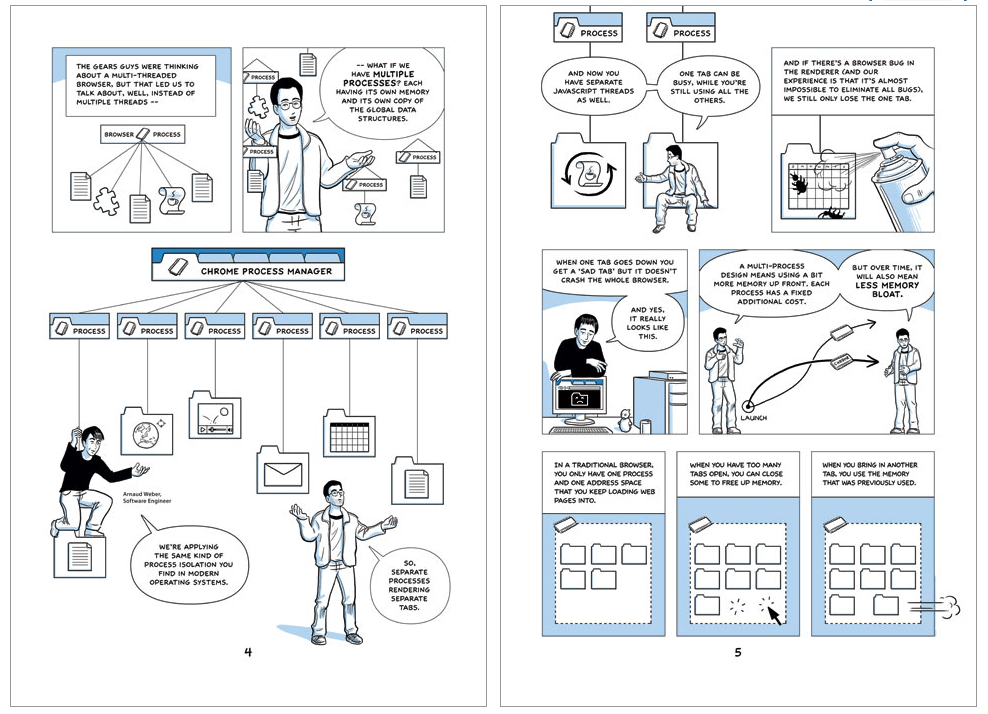
Google assembled an A-team of experienced browser developers to build Chrome. Ben Goodger, who had done stints at Netscape and Firefox before joining Google in 2005, was put in charge of the Chrome project, including hiring. Between 2005 and 2006, Google poached several prominent developers from Firefox, including Darin Fisher, Pam Greene, and Brian Ryner. Their job was to create an entirely new type of browser built on top of the HTML layout engine, WebKit, that would support “always-on” web apps like Google Maps.
Despite the technical challenges of essentially creating brand-new web technologies, the Chrome team had one crucial advantage over the competition. They were starting entirely from scratch. While the engineers working on IE and Firefox were also trying to adapt their browsers for an increasingly diverse range of tasks and applications, they had to do so using legacy tech. Google, on the other hand, could focus on building custom tools without worrying about any patterns that were used in the past to create browser technology.
Very early on, it was decided that Chrome would “sandbox” each tab into its own process. This approach solved multiple problems. One, it prevented one tab from crashing another, resulting in a more stable browsing experience. Two, it made individual processes faster so multiple processes could be run concurrently. Three, it aligned much more strongly with where the web was headed. Apps, not pages.
“Our web browsers should separate browser tabs into their own processes, multi-thread all communications with the operating system, boost cache sizes, and not be afraid to command more bandwidth when available. Internet Explorer 8, Firefox 3.1, and Apple Safari are taking fresh approaches to web browsers for modern machines, but Google Chrome has the advantage of a fresh start to achieve some features not currently possible in other browser architectures.” — Niall Kennedy
Google wasn’t messing around. By its own admission, Google was rethinking the entire concept of the browser from the ground up. Google was searching for the most difficult, core problems with browser technology and aimed to solve those problems more effectively than anyone else.
Although Google wasn’t shy about announcing its intentions for the future of the web browser, the way in which it went about actually working on Chrome was most definitely unorthodox. Google had relied on aspects of Apple’s WebKit rendering engine and Mozilla’s Firefox to build Chrome, but Google didn’t just want to build a better browser. Google wanted enthusiastic developers to help. That’s why Google decided to open-source the entire endeavor as part of its Chromium Projects in September 2008.
This was brilliant for two reasons:
- Making The Chromium Projects open-source gave Google a much better way to consistently improve Chrome as a product.
- It aligned strongly with the open-web standards that were becoming increasingly popular thanks to the advocacy of the open-source community and organizations such as Mozilla.
It didn’t hurt that Microsoft, at that time Google’s biggest target, was taking the complete opposite approach to developing IE by keeping it closed.
By July 2009, just nine months after Chrome’s official launch, more than 30 million people were browsing the web with Chrome. Chrome was fast, really fast, and people had noticed. July 2009 was also when Google announced its forthcoming Chrome operating system.
“We’re designing the OS to be fast and lightweight, to start up and get you onto the web in a few seconds. The user interface is minimal to stay out of your way, and most of the user experience takes place on the web. And as we did for the Google Chrome browser, we are going back to the basics and completely redesigning the underlying security architecture of the OS so that users don’t have to deal with viruses, malware and security updates. It should just work.” — Google
In December 2009, Google launched its extensions gallery. An overview of the many third-party plugins that users could install in Chrome to give the browser additional functionality, the extensions gallery showed just how versatile Chrome’s extensions could be.
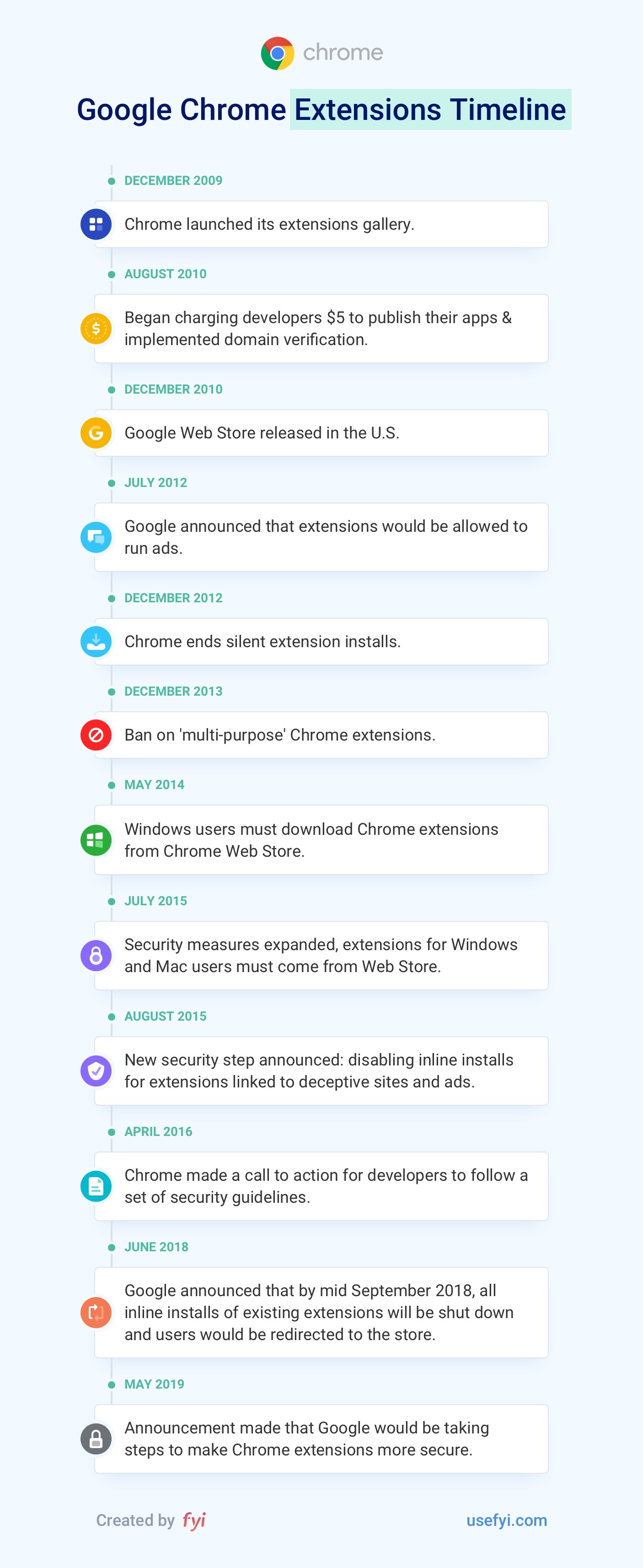
Extensions, plugins, and add-ons may be ubiquitous today, but in 2009, this was a pretty radical concept. With the possible exception of its sandboxed tabs, extensions are arguably the defining feature of Chrome as a product. They were also wildly popular. By December 2010, just one year after launching the extensions gallery, there were more than 8,500 extensions and 1,500 browser themes available via the extensions gallery. Around one-third of Chrome’s 120 million+ users had at least one extension installed, and more than 70 million extensions and themes had been installed across the entirety of Chrome’s userbase.
Chrome experienced dramatic growth in 2010, tripling from 40 million users at the beginning of the year to more than 120 million by the end of 2010. Chrome’s speed was a major factor behind this growth. Alongside its userbase, Google also grew its share of the browser market substantially during this period. At the end of 2009, Chrome had roughly 5% market share. Just one year later, Chrome had 15% market share.
“Chrome makes browsing a dream, and it just keeps getting better. The teams at Firefox, Safari, Internet Explorer, and Opera should take notice: Chrome’s now the one to beat.” — Farhad Manjoo, Salon
People wanted a faster, lighter browser, and Chrome delivered. Internet Explorer may still have been the dominant browser by the end of 2010, but Google was closing in. In an ironic twist, Google was beating Microsoft at its own game. Having been bruised by its fight with the federal government over anticompetitive practices for bundling IE with Windows to effectively dominate the market, Microsoft soon found itself on the losing end of the exact same strategy. By making a faster, lighter alternative to IE, Google had gained an invaluable advantage over Microsoft by giving people the choice to make Chrome their default browser. From here, it was just a hop, skip, and a jump to making Google the default search engine for Chrome users.
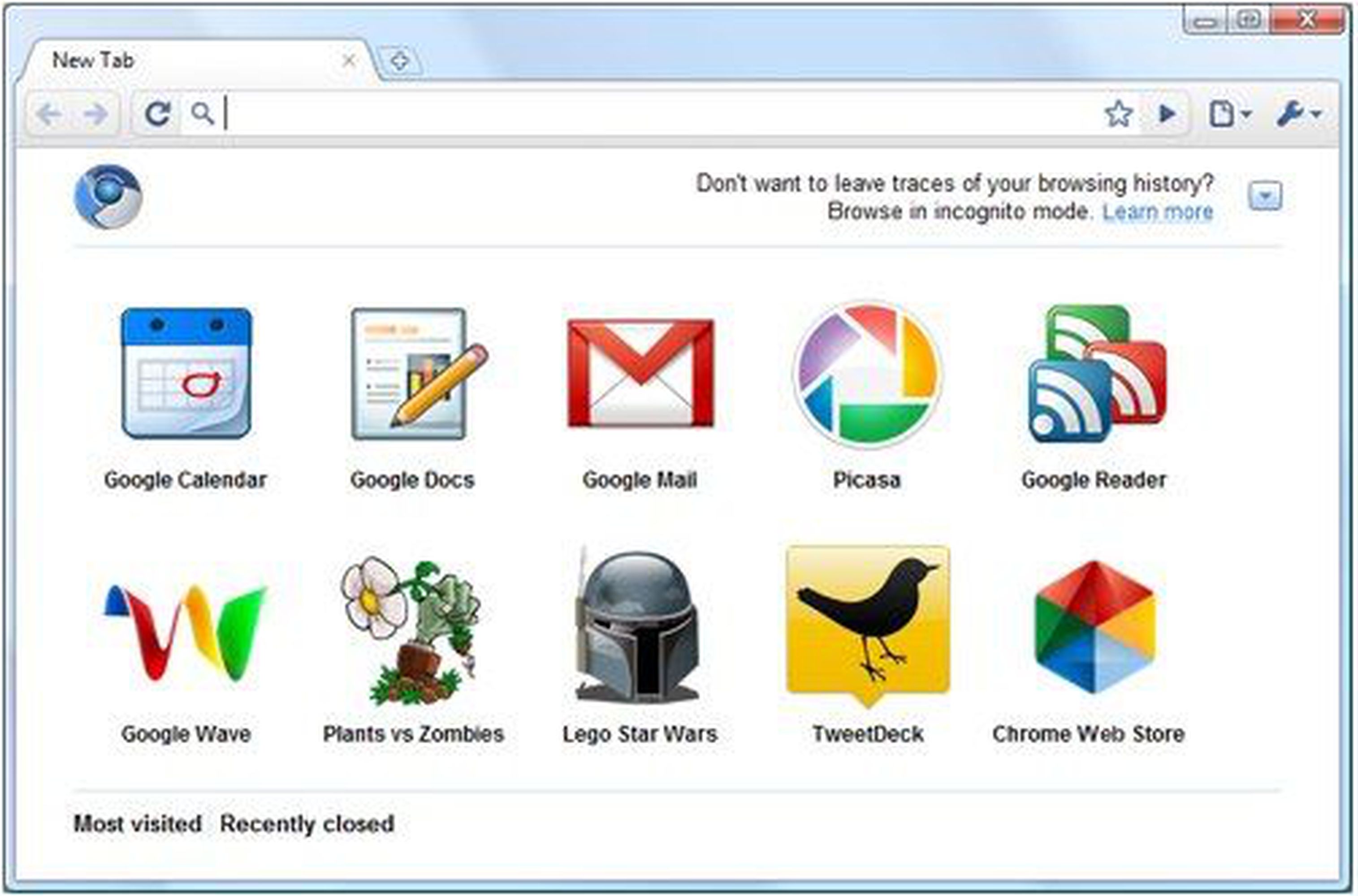
Google rounded out 2010 by launching the Chrome Web Store. Initially limited to the U.S., the Chrome Web Store was a bigger, better incarnation of Google’s extension gallery. Through the Chrome Web Store, users could browse and install extensions, plugins, and themes from thousands of independent developers. The extensions and plugins available through the Chrome Web Store made Chrome significantly more versatile. It also made extensions a critical part of the broader Chrome ecosystem, a smart long-term play that built upon the extensibility of Chrome and kept the focus tightly on the needs and expectations of the user.
Like Firefox’s plugins, Chrome’s extensions weren’t just popular little tools to help users do more with their browsers. They were the vanguard of a new wave of software products that would ultimately reshape entire industries by putting the user first. Take Adblock Plus, for example.
Adblock Plus is one of the oldest browser extensions on the web, having been around since 2007. It has been downloaded and installed millions of times. It’s one of the simplest, most effective extensions available for Chrome and Firefox. And it has almost single-handedly changed how people perceive traditional online publishing and the viability of certain online advertising business models. One could argue that Adblock Plus, a single extension developed by a single publisher, helped give rise to the subscription model we see everywhere today, from streaming entertainment services to SaaS. Adblock was immensely popular, so much so that it literally helped change how the Internet works. This is what makes extensions so powerful.
Early 2011 was largely quiet for Google. That changed in March 2011 when Chrome received its first major design makeover. The original Chrome logo had been stylized to appear metallic and three-dimensional, a nod to the product’s name. However, by 2011, Chrome’s 3D logo already felt pretty dated. Combined with the emerging trend toward “flat design” pioneered by Apple, it was clear that a refresh was necessary. Chrome’s new simpler, cleaner logo reflected the “easy and clutter-free” experience of using the product. The blue-tinted logo for the open-source Chromium project also got a makeover.
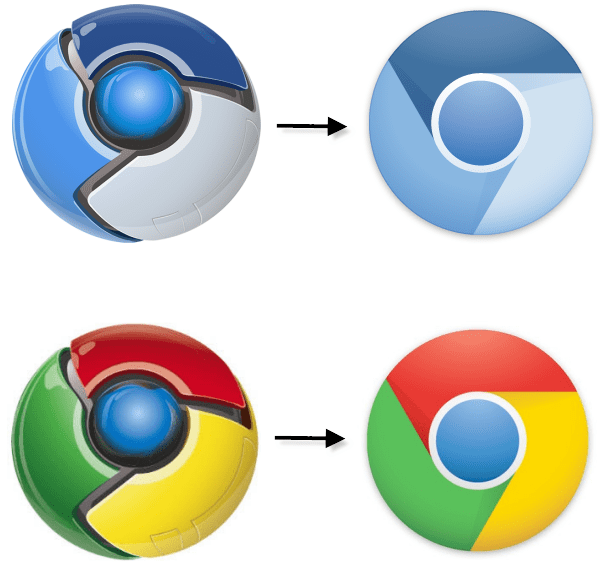
Shortly after Chrome’s logo was overhauled, Google announced its Chromebook line of netbooks. Google envisioned the Chromebook as the future of lightweight portable computing. These machines lacked a traditional hard drive and could not have software installed on them. Instead, they would run Chrome OS and rely on Chrome itself as users’ primary means of accessing the web.
In October 2011, Google quietly updated Chrome to include the next new feature that other browsers would soon imitate, the New Tab Page. Tabs had been transformative for many Internet users and had given people a taste of true online multitasking. Before the advent of tabbed browsing, most people probably wouldn’t have opened a new browser window for each task they wanted to work on. Tabs not only made this kind of online workflow possible, but even preferable. However, until now, opening a new tab had been a missed opportunity. Aside from a user’s predefined homepage, a new tab was a blank page. Now, Chrome’s New Tab Page made Chrome feel even more like an application by giving users quick access to the extensions, pages, and sites they used most frequently.
Google’s next move was to expand Chrome’s footprint beyond Windows. In February 2012, Google released Chrome for Android. Google loyalists had been waiting patiently for an Android version of the browser for years. The only real surprise about Chrome’s Android launch is how long it took for Google to get around to releasing it.
Three months after Chrome for Android finally launched, Google unveiled its latest hardware product, the Chromebox, a compact machine designed to function like a Chrome OS-driven desktop. However, like the Chromebooks before it, the Chromebox failed to impress.
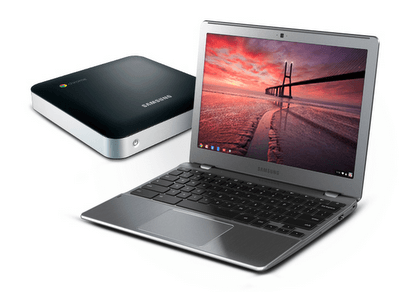
The Chromebox’s biggest problem wasn’t necessarily the product itself, though many analysts and tech journalists noted the Chromebox’s high price and low specs. It was that there just wasn’t enough demand for it.
When Google first floated the idea of a lightweight notebook computer designed and optimized for the cloud, the concept had a great deal of promise. That changed practically overnight on April 3, 2010. That’s when Apple unveiled the first iPad. Suddenly, the idea of paying a premium price for a stripped-down laptop with no hard drive and very limited offline functionality wasn’t nearly as appealing as it had been before Apple single-handedly reshaped the landscape of the consumer electronics market.
“Let’s cut to the chase. Samsung’s new Chromebook and Chromebox are simply too expensive for what you get. The Chromebox is $329 – an outrageous amount of money for a Celeron-powered desktop. Faced with the choice of outfitting an office with a suite of retina display iPads – which will be able to access 700,000 iOS apps and remain exceedingly portable – versus laptops that can’t even store a file if you’re offline, which would you choose?” — Christina Warren, Mashable
The other major problem with the Chromebox is that it was ostensibly a desktop PC designed for and marketed to businesses by a company that had no idea how to design and market hardware to businesses. The fact that Google abandoned its subscription-based pricing model in favor of a flat retail price and a one-time $150 charge for more administrative tools, a hardware warranty, and lifetime customer support access clearly revealed that Google saw the Chromebox as a business machine.
Google had made no secret of its clear intent to go after Microsoft with Chrome. It had learned a great deal about institutional sales as it developed tools like Apps for Education. But mimicking the same strategy Microsoft had used to penetrate the enterprise in the ’90s made virtually no sense.

The next month in June 2012, Google released Chrome for iOS. By this point, Chrome’s growth had been rapid, with the number of active Chrome users worldwide almost doubling from 160 million in June 2011 to more than 310 million users in June 2012. Launching Chrome for iOS would help Google expand the footprint of its browser even further. June 2012 was also when Google announced that extension developers would be permitted to include ads in their extensions using Google’s AdSense program. This was a significant departure from Google’s earlier position, in which all ads were forbidden from Chrome extensions. This was welcome news to many extension developers who finally had permission to directly monetize their add-ons.
By the summer of 2012, Google had accomplished what many had once said to be impossible. Chrome achieved 31% market share, finally dislodging Microsoft’s IE from the coveted top spot as the world’s most popular browser. Chrome’s development as a product deserves recognition in its own right. But Microsoft’s failure to embrace the changing web and the sluggish pace of IE’s development had made Chrome’s ascension that much easier.
This crucial milestone wasn’t just a win for Google in terms of users or potential reach. It was a sign that Google’s vision for the future of the web was coming to pass.
Until now, Chrome’s extensions had been one of the most popular and widely used aspects of the browser. However, the popularity of extensions had also resulted in some persistently challenging problems for Google, especially on Windows. In December 2012, Google announced that it was banning so-called “silent extension installs,” which refers to the practice of bundling extra “hidden” extensions into an extension without informing the user.
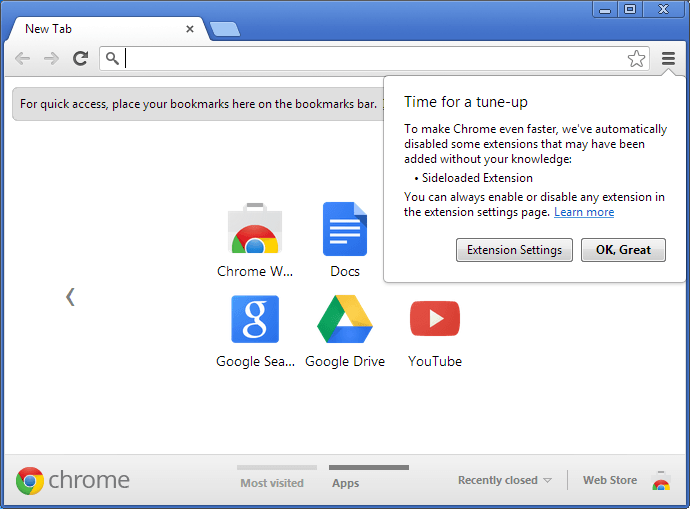
The main problem behind silent extension installs was a loophole in how Windows handles registry entries. The purpose of Windows’ registry mechanism was to permit users to install useful extensions to Chrome during installation of other extensions. Unfortunately, this system was abused extensively by unscrupulous extension developers trying to circumvent Google’s policy restrictions, forcing Google to take action.
After several years of fairly rapid development and product launches, Google took its foot off the gas with Chrome for much of the next year. The next major development in Chrome’s journey came in September 2013 when Google announced the launch of Chrome apps.
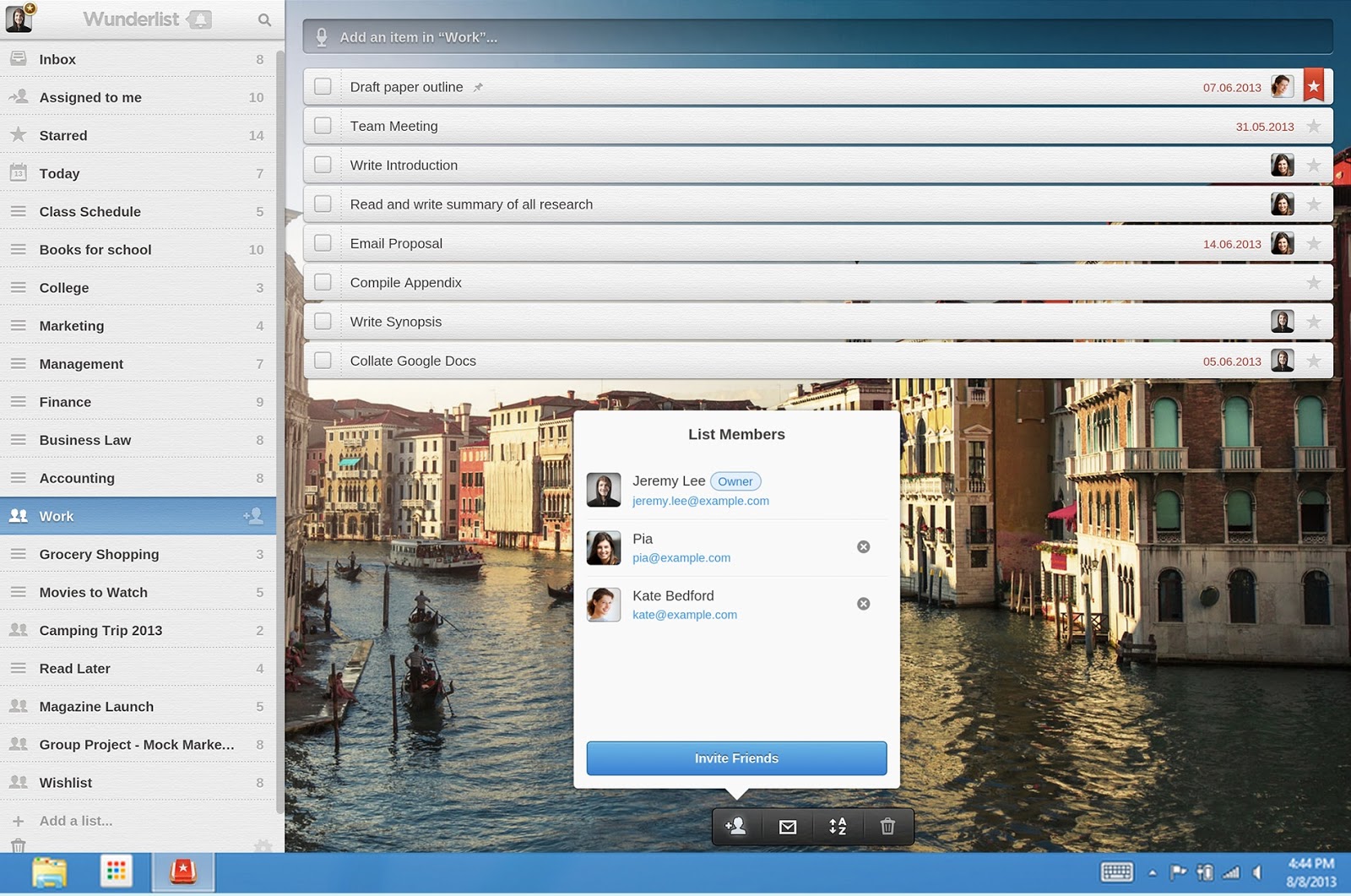
Chrome apps looked and felt a little like some of the Chrome extensions that were available in the Chrome Web Store. The biggest difference was that Chrome apps were closer to true applications than widgets. Accessible via the now-defunct “For your desktop” collection in the Chrome Web Store, Chrome apps were lightweight applications that ran natively in Chrome. A broad range of Chrome apps was available at launch, from productivity tools, such as to-do lists and calculators, to distractions like browser-based games and puzzles.
The apps themselves weren’t the most interesting part of Chrome apps, though it was how they worked. For one, Chrome apps were fully functional offline. They could be configured to interact with external devices such as USB-enabled peripherals, cameras and printers. They could access files stored on a user’s local machine as well as files stored in the cloud. Chrome apps synced across multiple devices automatically. And perhaps most important of all they could be launched directly from Google’s new Chrome App Launcher, which Google released at the same time as Chrome apps. This was another step toward making Chrome feel like a true computing platform in much the same way the New Tab Page did.
By November 2013, Chrome’s extensions had proven wildly popular. However, Google had not yet managed to get its problems with malicious third-party extensions under control. This led to Google instituting a policy in which all Chrome extensions were now required to be hosted in the Chrome Web Store. This wouldn’t be the end of Google’s extension woes, but it was a necessary and important step in the right direction.
“Many services bundle useful companion extensions, which causes Chrome to ask whether you want to install them (or not). However, bad actors have abused this mechanism, bypassing the prompt to silently install malicious extensions that override browser settings and alter the user experience in undesired ways, such as replacing the New Tab Page without approval. In fact, this is a leading cause of complaints from our Windows users.” — Erik Kay, former Engineering Director, Google
In just a few short years, Google had taken several aggressive steps to assert itself in the browser space. Google’s vision of the browser-as-a-platform was critically important to the product’s development. However, while Chrome had proven popular, Microsoft’s IE and Mozilla’s Firefox both still had significant market share, and the browser wars were far from over. In fact, things were just beginning to heat up.
2014-Present: Winning the Browser Wars
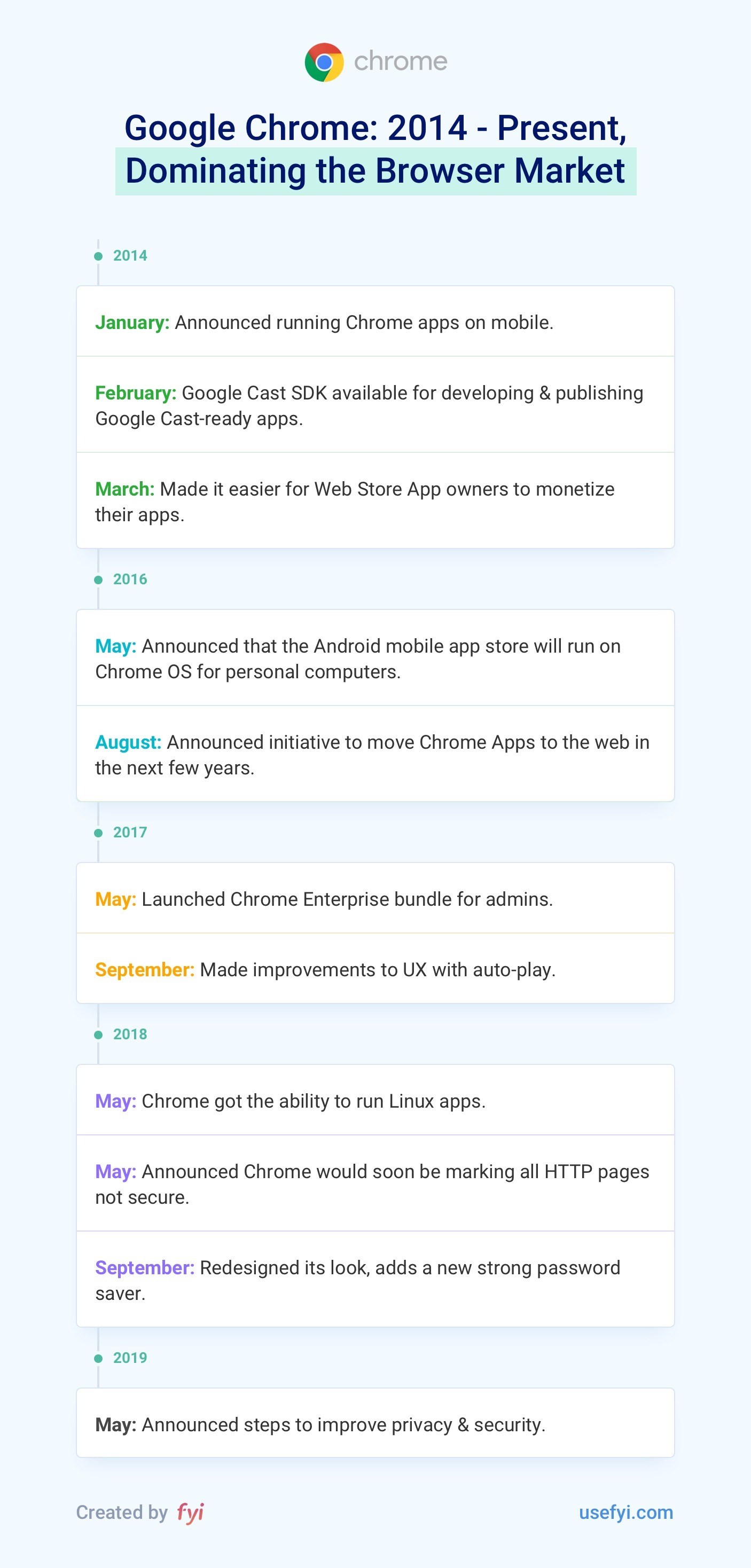
Google began 2014 in a very strong position with its Chrome browser. Chrome now accounted for roughly 40% of the browser market, a 155% increase in just five years. More than 310 million people were using Chrome as their primary browser. For the next several years, Google would aggressively leverage its position to seize further market share from Microsoft by expanding the footprint of Chrome around the world, and build new tools that aligned with the changing ways in which people lived their lives online.
The first significant move Google made in 2014 was to launch Chrome apps on mobile in January. This wasn’t the biggest deal, but it was nice to see Chrome apps on mobile instead of being limited to desktop. Google was using Chrome as a foothold to reach users where they lived online. Initially, that meant going after desktop users. Google wanted to insert itself into virtually every aspect of its users’ online lives and Chrome would be the vector.
In keeping with the spirit of the Chromium Projects, Chrome apps for mobile were built using Apache Cordova, an open-source mobile development framework for building native apps for mobile using just HTML, CSS, and JavaScript.
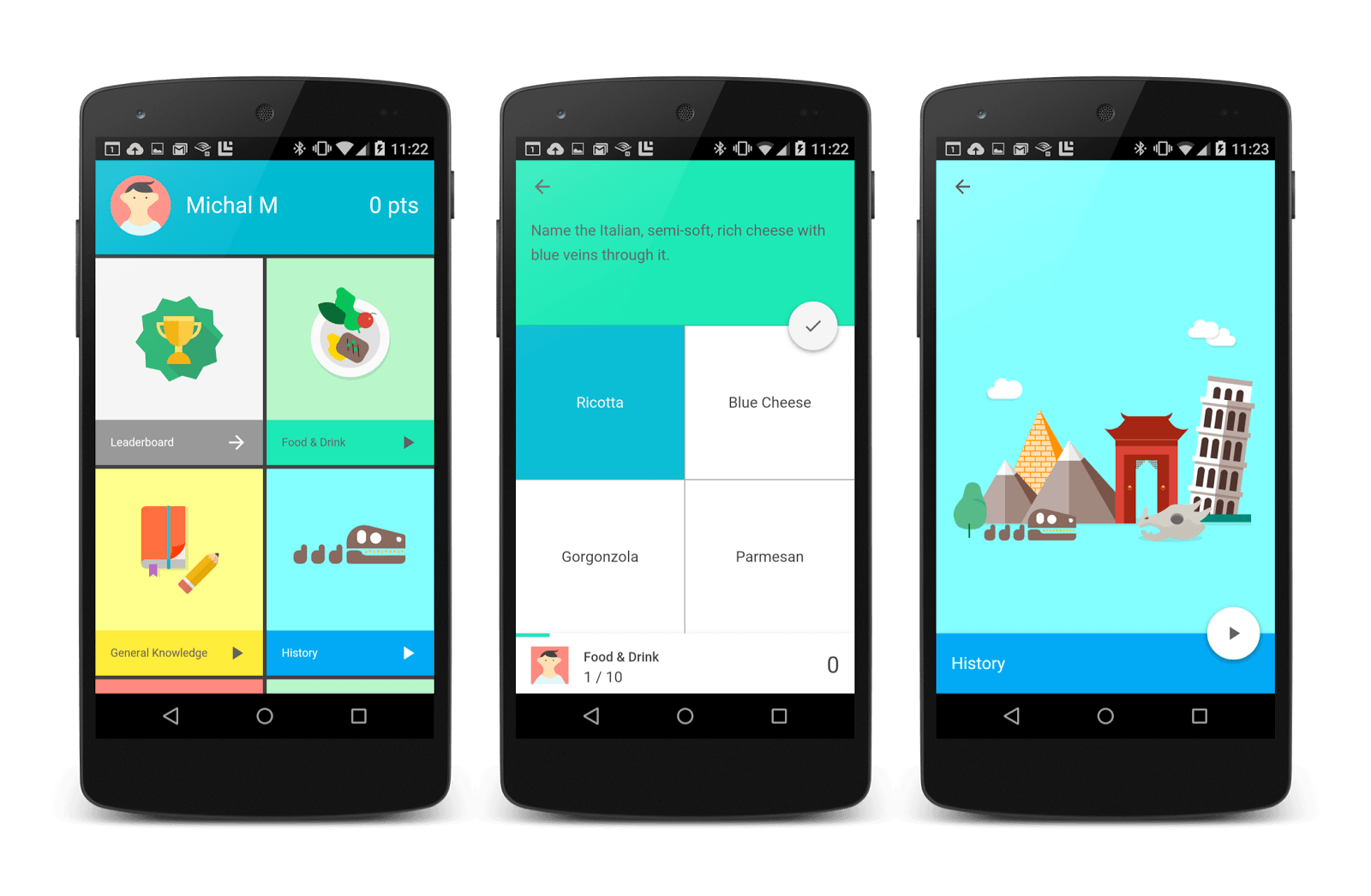
In March 2014, Google made some pretty major changes to how Chrome app developers could monetize their products. Before the update, apps hosted by Google could already monetize their apps in four way a free-trial period, upfront one-off payments, subscriptions, and in-app payments. Now, developers of packaged apps, themes, and extensions could also take advantage of these flexible monetization options.
What was noteworthy about this monetization overhaul is that extension developers got the best deal; many of the monetization options weren’t suitable for themes, and packaged apps could already implement both upfront payments and subscription-based pricing. Only extensions were given all four monetization options as part of the update. This didn’t make many waves at the time, but it was another indication that Google clearly saw extensions and the third-party ecosystem it had built around Chrome to be an essential part of the product’s future.
While Microsoft, Mozilla, and Apple were all working to make their own browsers more appealing, Google continued to smash major milestones. Speaking at Google’s annual I/O developer conference in May 2015, then-SVP of Product, Sundar Pichai, confirmed that Google Chrome had surpassed more than 1 billion users worldwide.
While Chrome didn’t see many significant updates between 2014 and 2016, the same cannot be said for Chrome’s extensions. The year 2015, in particular, was a big one for Chrome extensions. At that time, developing extensions for Chrome was no longer seen as a side hustle for enterprising software developers. Extensions were becoming big money. Several major tech companies including Dropbox and Microsoft released Chrome extensions that made their products even more useful. At other startups, Chrome’s extensibility as a browser was seen as a crucial element of many products’ roadmaps, including calendar and email tool Cirrus Insight, sales engagement tool Tout (which was later acquired by marketing automation platform Marketo), and email marketing tool Yesware. This spoke volumes about how Chrome was perceived as a product and how important it was to the growth strategies of many startups.
“Startups are proving businesses can get traction and funding with browser extensions being a core part of their offering. Large, established vendors are releasing browser extensions of their own, and the browsers themselves are converging around a standard way to develop extensions such that they are secure and can work cross-browser with minimal effort. These are strong signals around the continued importance browser extensions play in the way we work.” — Rick Nucci,TechCrunch
In 2015, other browsers finally started getting serious about their own extensions. Microsoft had announced in January 2015 that its new Edge browser, which still looked and felt a lot like IE and was still going by its “Spartan” codename at that time, would support extensions. The fact that Microsoft also confirmed Edge would be the default browser in Windows 10 and that support for IE would formally end on January 12, 2016 finally heralded the end of what might just be Microsoft’s most hated product. Similarly, Mozilla announced it was releasing a new API for extension developers known as WebExtensions that would make developing add-ons for multiple browsers easier.
Developing and publishing extensions for Chrome had gotten much easier. For Google, however, protecting users from malicious third-party developers was still a major headache for the search giant. Chrome had offered inline installation, the process of allowing extensions and apps to be downloaded and installed “inline” directly from a webpage, even if the extension or app was hosted by the Chrome Web Store since 2011. However, malicious exploitation of inline installation had been a comparatively minor but persistent challenge for Google. Disabling inline installations was the latest step Google had been forced to take in order to get its malicious app and extension installation problems under control.
Until this point, Google had been developing its Android mobile OS and its Chrome OS largely independently of one another. In May 2016, speculation began to grow that Google was planning on potentially merging the two operating systems when Google announced that its Google Play Store for Android apps would now run on Chrome OS. Running Android apps on Chrome OS made many of the apps available through the Google Play Store compatible with its range of Chromebooks, which lacked support for apps such as Microsoft’s Skype until that point.
A couple of months later, Google dropped another bombshell when it announced its plans to migrate Chrome apps hosted on Chrome OS to native web apps.
“As we continue our efforts to simplify Chrome, we believe it’s time to begin the evolution away from the Chrome apps platform. There are two types of Chrome apps: packaged apps and hosted apps. Today, approximately 1% of users on Windows, Mac and Linux actively use Chrome packaged apps, and most hosted apps are already implemented as regular web apps. We will be removing support for packaged and hosted apps from Chrome on Windows, Mac, and Linux over the next two years.” — Rahul Roy-Chowdhury, VP Product Management at Google
The reason for Google’s apparent 180 about its Chrome apps was simple. Chrome’s extensions were incredibly popular. Chrome apps were not.
In classic Google fashion, however, many people were immediately and understandably confused by the announcement, not least because of Google’s habit of relying on confusing naming conventions. Was their favorite extension really an extension, or was it an app? What about products that were available as both apps and extensions?
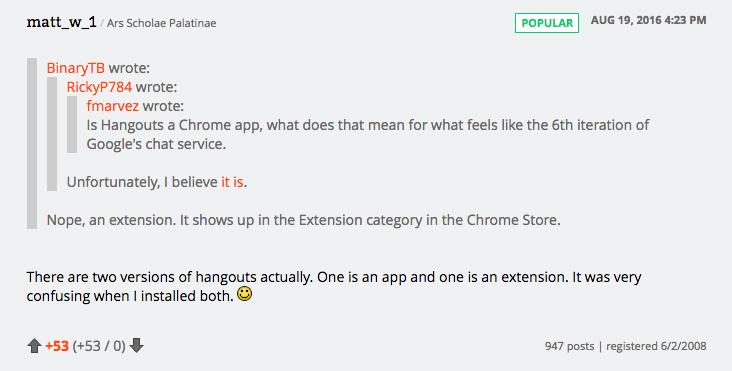
For the next year or so, Google kept its work on Chrome mostly under wraps. By 2017, Google Chrome had 55% of the browser market share. Thanks to its speed and sandboxed tabs, Chrome had proven incredibly popular with users but the browser had also been making quiet inroads into the enterprise.
In May 2017, Google launched the Chrome Enterprise Bundle. Google had never been coy about competing with Microsoft in the workplace, but the launch of the Enterprise Bundle was among the most aggressive moves into the enterprise space Google had made to date.
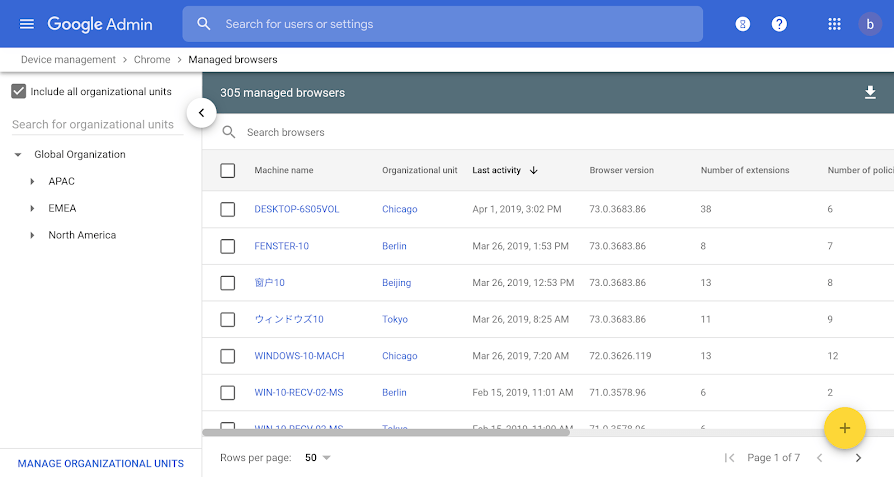
The Bundle gave system administrators a single installer for Chrome that they could use to deploy the browser to potentially thousands of users across an organization. It also shipped with the Chrome Legacy Browser Support extension that allowed enterprise users to run older, deprecated apps as well as administrative policy templates. At the time, Google claimed that the number of enterprise companies using Chrome had “doubled,” but a spokesperson declined to offer any specifics. Chrome now supported Citrix’s XenApp virtualization platform and Windows Server, both of which are used extensively in many enterprise environments. The launch of the Chrome Enterprise Bundle was another indication that Google was serious about challenging Microsoft on its home turf.
One of Chrome’s most welcomed updates came in September 2017 when Google introduced changes to the ways in which autoplay media, such as interstitial video ads, were handled in the browser. This seemingly minor update, which Google called “unified autoplay,” was a huge improvement to Chrome’s UX and gave users much more control over their browsing experience. The update only allowed media content to autoplay if the media file did not play sound or the user indicated an interest in that kind of media content. In addition, users could now selectively disable audio playback for specific sites which was perfect for preemptively silencing annoying sites with random autoplay video ads.
After the introduction of unified autoplay, Chrome went quiet for more than six months. The next major update to Chrome came in May 2018 when Google announced that Chrome would now support Linux apps.
At first, this didn’t seem like a particularly big deal to some people. From a consumer perspective, Linux has always been a niche OS. However, Google wasn’t supporting Linux apps for its growing userbase – it was supporting them to make developers’ lives easier. Chrome’s speed and ease-of-use are often positioned as consumer-focused benefits, but Google has always been a dev-friendly company. Just as Google did when it set out to make it easier for developers to work with emerging Internet technologies in 2008, Google’s support for Linux apps in Chrome was a similar step toward encouraging devs to make more applications and extensions for the growing Chrome ecosystem. As if further proof were needed, Google’s announcement that Android Studio was being developed for Chrome OS was another indication that developers remained an important audience for its new tools.
“While the average user might not get too excited about Linux software, it’s big news for developers and coders who rely on those tools to create new applications and software. Plus, given Google’s major education boost with Chrome OS, having the ability to run development environments means that Chromebooks just became an incredibly valuable tool for computer science and engineering students who are learning how to code.” — Chaim Gartenberg, The Verge
May 2018 was also when Google announced it would soon be marking all non-HTTPS pages as “not secure.” This was a move Google had been waiting to make for some time. The company had wanted to implement its new security labeling much sooner. Unfortunately, broader adoption of HTTPS as a standard was still too low to make the switch to Chrome’s security indicators. The company confirmed that the rollout of the new indicators would begin in September and would be rolled out everywhere with the release of Chrome 70 in October 2018.
September 2018 marked the ten-year anniversary of Chrome’s launch. By this point, there were more than 2 billion active Chrome installations worldwide and Chrome had roughly 62% of the market share. However, Chrome’s ascension from a scrappy underdog to the dominant incumbent had not been without incident. As Chrome expanded around the world, some users and security experts became increasingly concerned about Google’s emerging dominance of the browser space.
Chrome’s popularity meant that the browser had effectively become the de facto standard for web development. Just as devs once had to make sure everything ran smoothly in IE, they now had to do the same for Chrome. Except this went far beyond optimizing for a single browser. Due to Chrome’s dominance, many devs focused exclusively on Chrome to the detriment of other browsers. Features that were developed primarily for Chrome could often take weeks or even months to be implemented in Firefox, Opera, and other browsers.
Google had gone from champion of the open web to gatekeeper of contemporary web standards in just ten years.
“Google won by offering consumers a fast, customizable browser for free, while embracing open web standards. Now that Chrome is the clear leader, it controls how the standards are set. That’s sparking concern Google is using the browser and its Chromium open-source underpinnings to elbow out online competitors and tilt entire industries in its favor.” — Gerrit De Vynck, Bloomberg
Some experts felt Google had done far more than elbow out online competitors. Brendan Eich, cofounder of Mozilla and CEO of Brave Software, said that “Chrome has become spyware.” In an ironic example of how Google’s dominance is truly inescapable, Brave’s privacy-focused browser of the same name was built using Chromium. Other small-share browsers, such as the freeware Vivaldi browser that also emphasizes privacy and security, also experienced serious difficulties due to Google’s stranglehold on so many widely used products and services.
It was one of Google’s most popular services, Gmail, that alerted some users to a major change in Chrome that occurred at some point between July and September 2018.
Some users noted that, after the update, signing into Gmail in Chrome also signed them into Chrome itself. Likewise, logging out of Gmail logged them out of Chrome. Prior to the update, the two services had two separate logins. It was possible to be logged into one without being logged into the other. The September 2018 update apparently did away with this separation – and users were furious.
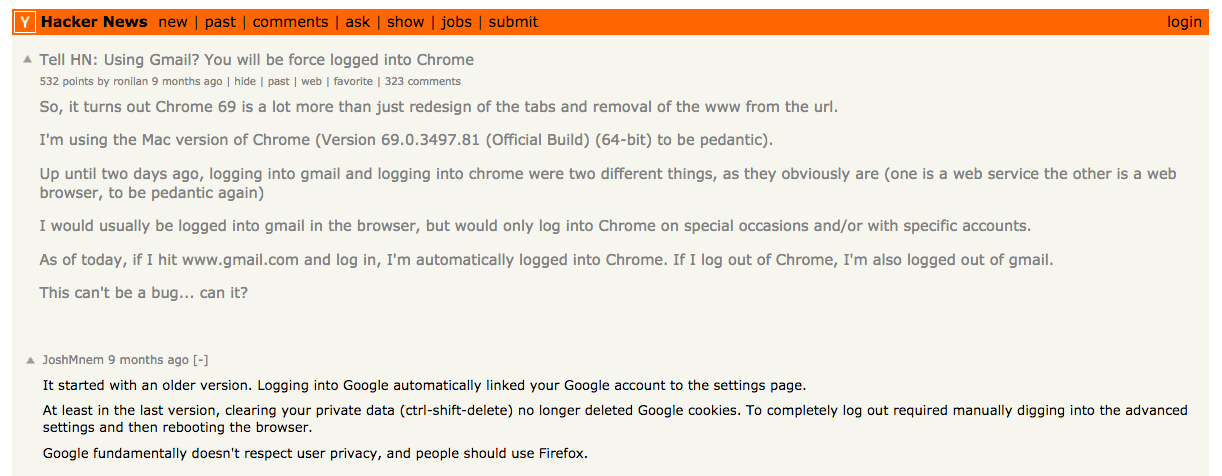
Many users, including long-time Chrome evangelists, were outraged at Google’s apparent deception. Some pledged to abandon Chrome forever in favor of the more privacy-focused Firefox. Others struggled to believe that Google would knowingly implement such a change, instead believing it to be a bug. It later transpired that some users had been affected by the change as early as July 2018.
Although the dual login between Chrome and Gmail could be manually disabled, the underhanded way in which Google implemented the change caused significant damage to Google’s reputation.
Matthew Green, a professor of cryptography at Johns Hopkins University, was particularly vocal about the privacy implications of the switch, taking to Twitter to express his skepticism about Google’s motives.
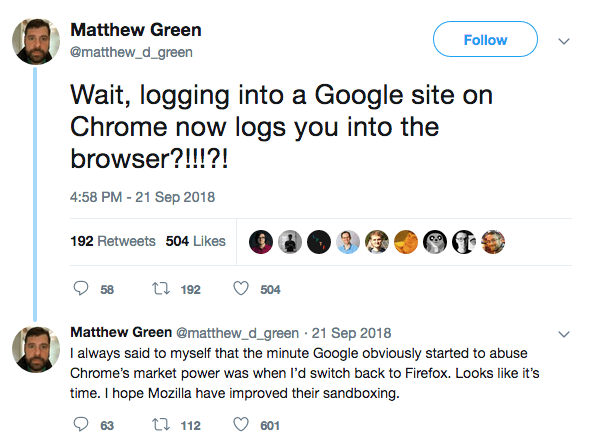
Predictably, Google positioned the change as a positive for users. Adrienne Porter Felt, an engineer on the Chrome team, tried to downplay the move in a tweet, describing the change as closer to a visual indication of a user’s sign-in status rather than a privacy vulnerability.
Just as predictably, Green wasn’t buying it.
Google claimed that its “identity consistency between browser and cookie jar” would make it easier for users to move files and data between Google services. In this regard, Google was right – it was more convenient for some users. It was also a lot easier for Google to datamine users’ browsing habits, search history, and email, giving it a much more complete picture of users’ behavior that it could then sell to advertisers. Google later backtracked and implemented a control that allowed users to more easily disable automatic Chrome sign-ins.
“Even if no data goes up [to Google’s servers] it’s still a huge change. This was a bright line they made. And they violated it without telling anyone, and only updated their privacy policy after the fact when people freaked out.” — Matthew Green, Associate Professor, Johns Hopkins University
By May 2019, Chrome had almost 70% of the browser market share. Although Mozilla’s Firefox had enjoyed something of a resurgence in interest following the various privacy scandals plaguing Google, other browsers had not been so fortunate.
Microsoft’s Edge browser, in particular, seemed to have almost entirely stalled – despite Microsoft’s admirable attempts to improve the browser. Much of the growth that Edge had experienced could arguably be attributed to broader adoption of Windows 10. Between 2016 and 2019, Microsoft made dozens of improvements to Edge, making it faster, more extensible, and more stable. But there was still virtually no reason to use Edge over Firefox or Chrome. Everything Edge could do, Chrome could do better.
That’s what made Microsoft’s decision to migrate Edge to the Chromium engine in December 2018 so stunning.
Edge had numerous legacy problems that were difficult to overcome. Edge relied on a completely different rendering engine than Chrome and Opera. This caused significant compatibility problems when displaying certain sites and pages. Edge also relied heavily upon Microsoft’s Universal Windows Platform (UWP) API, which isolated Edge from the broader browser community even further.
After the initial shock subsided, many advocacy groups and internet organizations were supportive of Microsoft’s decision, especially within the Chromium development community. But not everybody shared the enthusiasm for Microsoft’s choice to move Edge to Chromium. Mozilla, in particular, was deeply skeptical of the move, claiming it gave Google even more power over how future internet technologies would be developed.
“From a business point of view Microsoft’s decision may well make sense. Google is so close to almost complete control of the infrastructure of our online lives that it may not be profitable to continue to fight this. The interests of Microsoft’s shareholders may well be served by giving up on the freedom and choice that the internet once offered us.” — Mozilla
In just ten years, Chrome single-handedly reimagined what browsers could be and became the most popular web browser in the world. In addition to creating several new revenue streams for Google, Chrome also helped Google expand its already considerable footprint even further and reach new audiences with its products – and ads.
However, for all its popularity, Google has faced fierce criticism for Chrome’s privacy and security features. Chrome’s dominance seems assured for now, but as Microsoft could attest this could change very quickly if Google fails to adequately leverage the momentum it has built.
Where Could Google Chrome Go From Here?
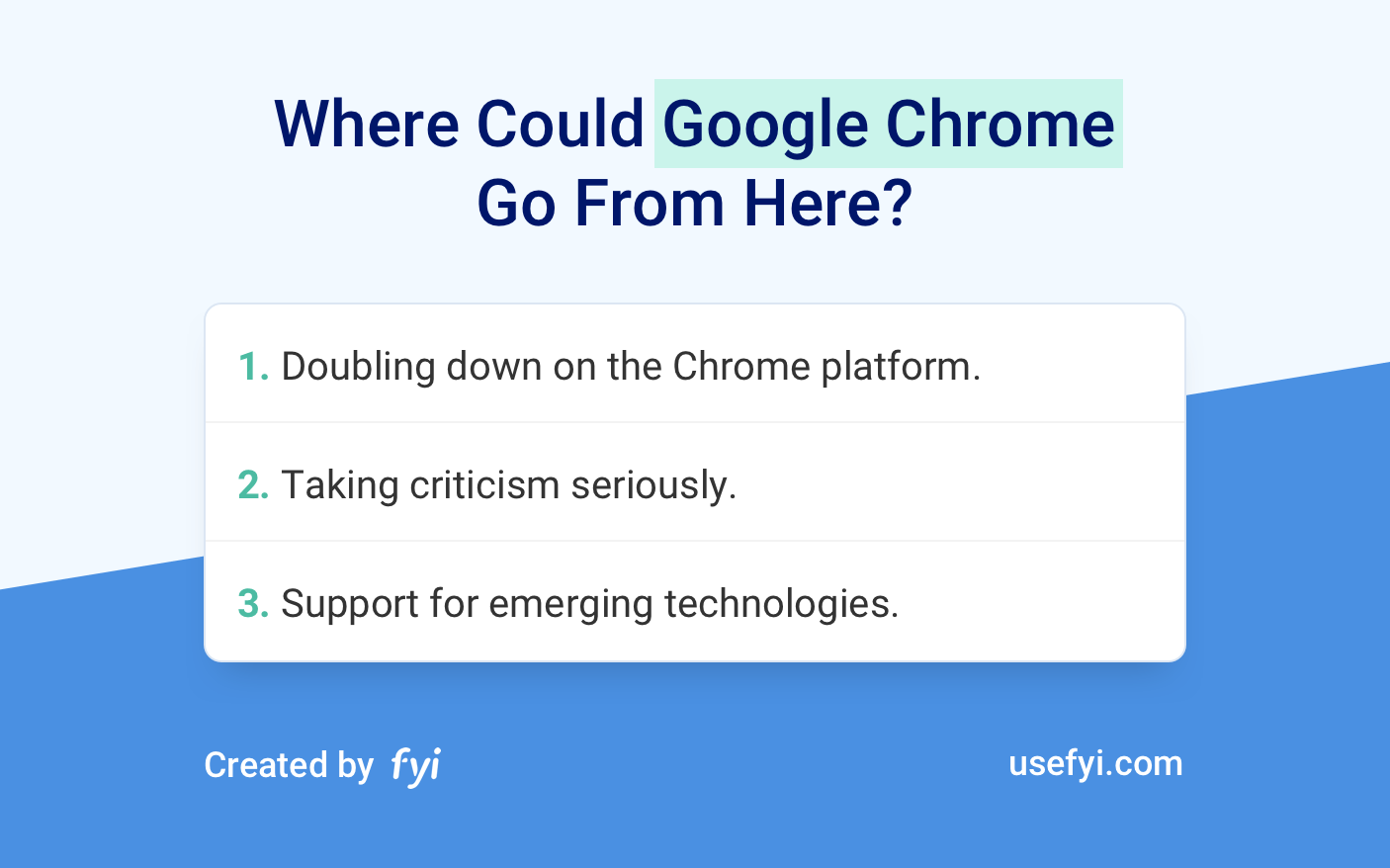
Having completely dominated the browser market in just a decade, what’s next for the world’s most popular browser?
- Doubling down on the Chrome platform. Google envisioned Chrome as a platform from the very beginning. As Google seeks to maintain its grip on the browser market, it seems likely that the company will double-down on Chrome’s nature as a platform. This might include specialized tools such as more extensions specifically for mobile and additional functionality to leverage the cloud in Chrome OS.
- Taking criticism seriously. For the most part, Google has done a great deal to advance emerging internet technologies and make the web better. It has also, however, invited criticism by making some questionable decisions, particularly regarding user privacy. Google has always iterated on Chrome to serve its users well. In the future, it’s possible that Google will also begin addressing some of the more serious concerns leveled at Chrome in a meaningful way.
- Support for emerging technologies. If Google is to continue its platform play with Chrome, it’s inevitable that support for technologies such as augmented reality (AR) and virtual reality (VR) will be introduced to the Chrome platform. Support for AR and VR represents an incredible opportunity for Google to once again take the lead technologically and an amazing opportunity for additional revenue.
What Can We Learn From Chrome?

Few companies can match the resources, reach, or influence of Google. That said, taking on an entrenched incumbent like Microsoft and winning in the span of just ten years is no easy feat, even for Google. What lessons does Chrome’s meteoric rise have to teach us?
1. Identify the core problems in your market and solve them better than anyone else. Google’s early approach to developing Chrome reveals the deep understanding the company had of the challenges – technical and otherwise – facing the internet industry circa 2008. Google recognized that developers were a key growth vector for its new browser, and it built Chrome to serve the needs of both developers and users.
Take a look at your product and its place in your market:
- What are the biggest problems facing your industry? Does your product solve those problems for other companies, consumers, or both?
- If you could change one thing about the climate of your industry, from the limitations of existing technologies to how users perceive products in your vertical, what would it be? How could your products solve your market’s most urgent problems and improve on that one thing you’d change?
- Be honest, is anyone else in your space innovating in ways that you are not? What could you do over the next six months to close the gap between your product and the competition?
2. Start small and execute over time to discover and capitalize upon emerging opportunities. Google could have built a better browser, iterated on it, and left it at that. Instead, Google built a better browser that turned into a product that captured 70% of the market share and became a platform with a thriving ecosystem.
Examine your product roadmap for the next year or so:
- How much room do you have to maneuver and seize emerging opportunities? Does your roadmap allow for some deviation, or are you firmly committed to a specific trajectory?
- How might you create opportunities to create additional value for your users and new revenue streams for your business?
- What’s on your list of “moonshot” features or ideas? How could you explore these ideas without negatively affecting your current growth?
3. Don’t assume you have to do things the same way they have been done before. The best products give people exactly what they expect from competing products, only in a much better way. For example, Google could have avoided anything even remotely resembling a browser toolbar. Instead, Google developed Chrome Extensions and have been tweaking and improving them ever since to sidestep the problems with toolbars altogether.
Find the most important problems to solve in your market and then innovate:
- What are the biggest challenges people have with the existing products in your market?
- What will your product do differently? Why will your product succeed where others failed?
- Looking at your product roadmap, in what areas is your product vulnerable to competing products? Put another way, what are the weakest areas of your product, and how might another company solve your customers’ problems better than you can?
Content, Not Chrome
Aside from building a better web browser, Google managed to almost single-handedly reshape how we interact with the web. Even users who prefer other browsers have benefitted from Google’s vision of the browser-as-a-platform as other browsers have adopted the standards Chrome introduced to the world.
However, despite Chrome’s strengths as a browser and a software product, Google has made some costly missteps, particularly when it comes to how it gathers and uses personal data. In the coming years, Google will have even more opportunities to shape the future of the web, the only real question is how responsibly it will do so.
Do you use Chrome? You can find your documents right from a new tab using the FYI Chrome extension.

